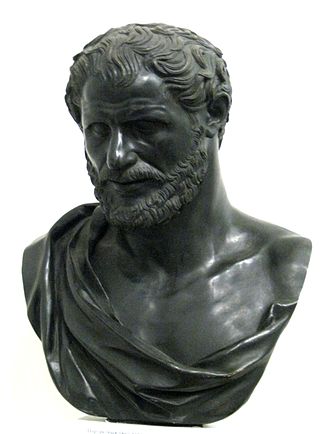
Democritus was an Ancient Greek pre-Socratic philosopher from Abdera, primarily remembered today for his formulation of an atomic theory of the universe. Democritus wrote extensively on a wide variety of topics.

Erasmus Robert Darwin was an English physician. One of the key thinkers of the Midlands Enlightenment, he was also a natural philosopher, physiologist, slave-trade abolitionist, inventor, freemason, and poet.

The Lunar Society of Birmingham was a British dinner club and informal learned society of prominent figures in the Midlands Enlightenment, including industrialists, natural philosophers and intellectuals, who met regularly between 1765 and 1813 in Birmingham. At first called the Lunar Circle, "Lunar Society" became the formal name by 1775. The name arose because the society would meet during the full moon, as the extra light made the journey home easier and safer in the absence of street lighting. The members cheerfully referred to themselves as "lunaticks", a contemporary spelling of lunatics. Venues included Erasmus Darwin's home in Lichfield, Matthew Boulton's home, Soho House, Bowbridge House in Derbyshire, and Great Barr Hall.
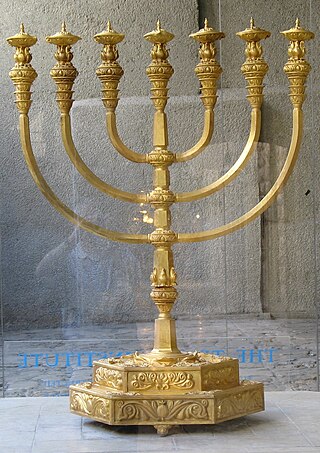
The menorah is a seven-branched candelabrum that is described in the Hebrew Bible and in later ancient sources as having been used in the Tabernacle and in the Temple in Jerusalem.

Joseph Wright, styled Joseph Wright of Derby, was an English landscape and portrait painter. He has been acclaimed as "the first professional painter to express the spirit of the Industrial Revolution".

Derby Museum and Art Gallery is a museum and art gallery in Derby, England. It was established in 1879, along with Derby Central Library, in a new building designed by Richard Knill Freeman and given to Derby by Michael Thomas Bass. The collection includes a gallery displaying many paintings by Joseph Wright of Derby; there is also a large display of Royal Crown Derby and other porcelain from Derby and the surrounding area. Further displays include archaeology, natural history, geology, military collections and world cultures. The Art Gallery was opened in 1882.

Moonlight consists of mostly sunlight reflected from the parts of the Moon's surface where the Sun's light strikes.

An Experiment on a Bird in the Air Pump is a 1768 oil-on-canvas painting by Joseph Wright of Derby, one of a number of candlelit scenes that Wright painted during the 1760s. The painting departed from convention of the time by depicting a scientific subject in the reverential manner formerly reserved for scenes of historical or religious significance. Wright was intimately involved in depicting the Industrial Revolution and the scientific advances of the Enlightenment. While his paintings were recognised as exceptional by his contemporaries, his provincial status and choice of subjects meant the style was never widely imitated. The picture has been owned by the National Gallery in London since 1863 and is regarded as a masterpiece of British art.

A Philosopher Lecturing on the Orrery, or the full title, A Philosopher giving that Lecture on the Orrery in which a lamp is put in place of the Sun, is a 1766 painting by Joseph Wright of Derby depicting a lecturer giving a demonstration of an orrery – a mechanical model of the solar system – to a small audience. It is now in the Derby Museum and Art Gallery The painting preceded his similar An Experiment on a Bird in the Air Pump.
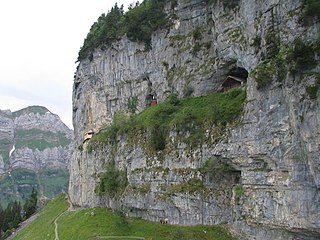
Wildkirchli are three interlinked caves situated in the Alpstein massif in the Appenzell Innerrhoden canton of Switzerland, north-east of Mount Säntis Switzerland. The caves are located at a height of 1,477–1,500 m (4,846–4,921 ft). They are notable for the traces of Paleolithic Neanderthal habitation, dating to c. 40,000 BP, and cave bear bones dating to 90,000–40,000 BP. A museum at the site houses a full bear skeleton that was found in one of the caves.

Peter Perez Burdett was an 18th-century cartographer, surveyor, artist, and draughtsman originally from Eastwood in Essex where he inherited a small estate and chose the name Perez from the birth surname of his mather, his maternal grandfather was the clergyman there. He would have been notable just for his many appearances in Joseph Wright's pictures but he was also involved with numerous projects including surveying the route for one of the major projects of the industrial revolution, the Leeds and Liverpool Canal, in 1769. He has been described as "if not in the centre at least in the penumbra of the Lunar Society of Birmingham". He spent the last years of his life in Karlsruhe, avoiding debtors, but still active in German society. His German daughter married a Count.
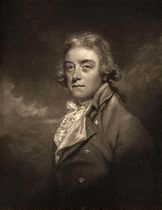
Sir Brooke Boothby, 6th Baronet was a British linguist, translator, poet and landowner, based in Derbyshire, England. He was part of the intellectual and literary circle of Lichfield, which included Anna Seward and Erasmus Darwin. In 1766 he welcomed the philosopher Jean-Jacques Rousseau to Ashbourne circles, after Rousseau's short stay in London with Hume. Ten years later, in 1776, Boothby visited Rousseau in Paris, and was given the manuscript of the first part of Rousseau's three-part autobiographic Rousseau Judge of Jean-Jacques. Boothby published it in Lichfield in 1780 after the author's death, and donated the document to the British Library in 1781.

The Derby Philosophical Society was a club for gentlemen in Derby founded in 1783 by Erasmus Darwin. The club had many notable members and also offered the first institutional library in Derby that was available to some section of the public.

The Midlands Enlightenment, also known as the West Midlands Enlightenment or the Birmingham Enlightenment, was a scientific, economic, political, cultural and legal manifestation of the Age of Enlightenment that developed in Birmingham and the wider English Midlands during the second half of the eighteenth century.

The Alchemist Discovering Phosphorus is a painting by Joseph Wright of Derby originally completed in 1771 then reworked in 1795. The full title of the painting is The Alchymist, in Search of the Philosopher's Stone, Discovers Phosphorus, and prays for the successful Conclusion of his operation, as was the custom of the Ancient Chymical Astrologers. It has been suggested that The Alchymist refers to the discovery of phosphorus by the Hamburg alchemist Hennig Brand in 1669. This story was often printed in popular chemical books in Wright's lifetime, and was widely known.

The Blacksmith's Shop is a recurring theme of five paintings by Joseph Wright of Derby. The version in his hometown was originally completed in 1771.
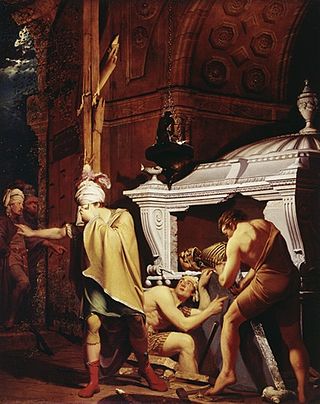
Miravan Breaking Open the Tomb of his Ancestors is a painting by Joseph Wright of Derby originally completed in 1772.

Three Persons Viewing the Gladiator by Candlelight is a 1765 painting by Joseph Wright of Derby and now resides in the Walker Art Gallery in Liverpool [United Kingdom]. It depicts three men examining a reproduction of the Borghese Gladiator, a famous Hellenistic statue discovered in Italy. The painting was one of the first in Wright of Derby's "Candlelight Pictures" series and was originally exhibited in London, gaining much attention. Four years later a mezzotint of it was made by William Pether.

Two Girls Dressing a Kitten by Candlelight is a "fancy painting" by Joseph Wright of Derby (1734–1797). The painting is displayed at the Kenwood House Public Museum, located in the London Hampstead area.

A Game of Tric-Trac is a painting by Judith Leyster from 1630.




















